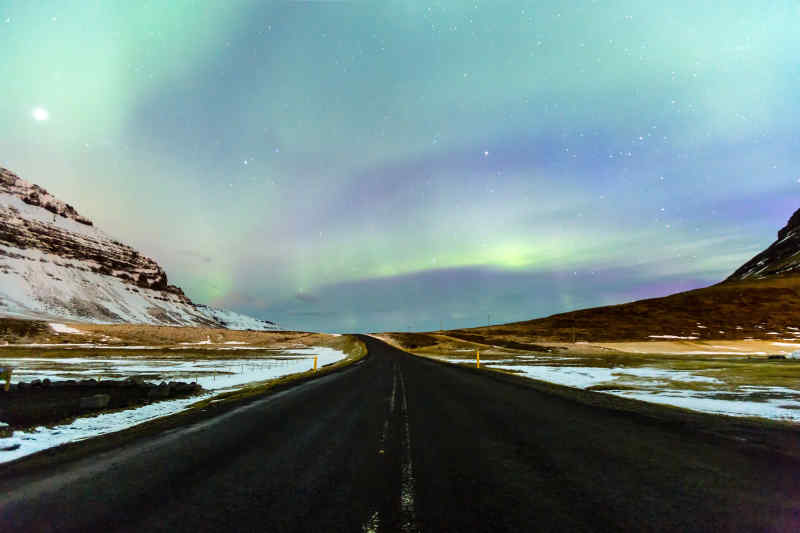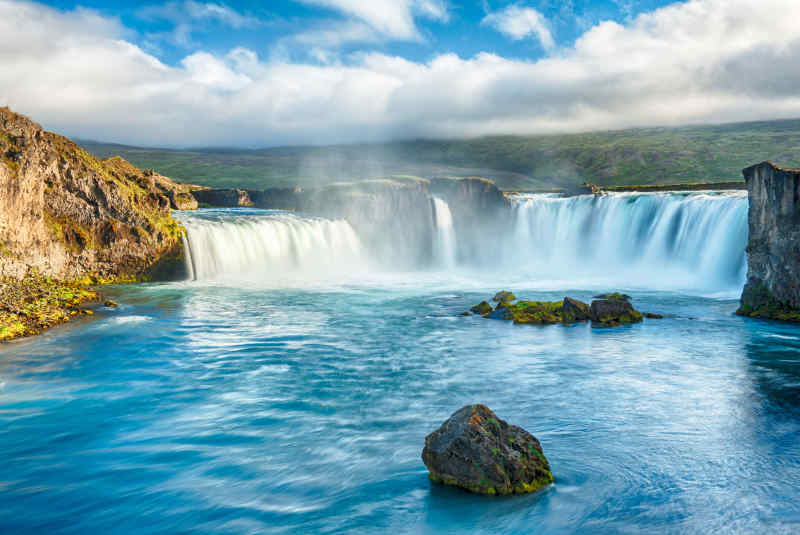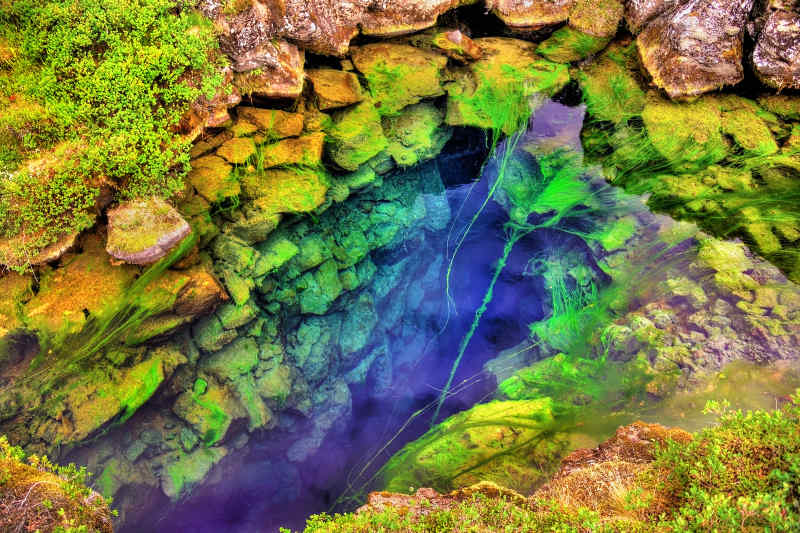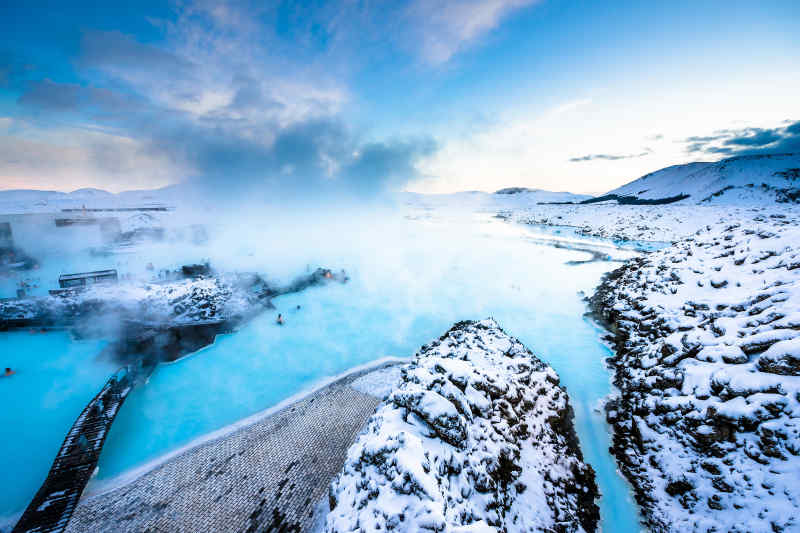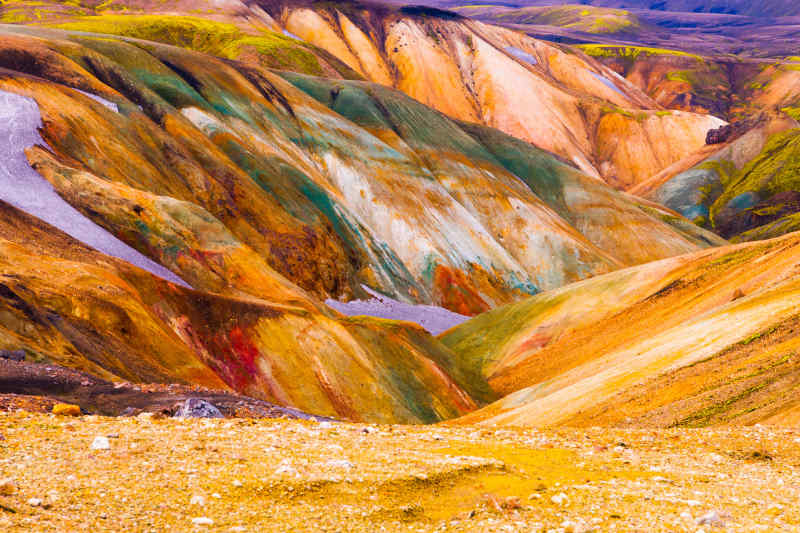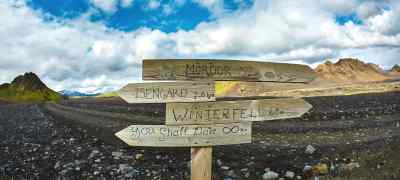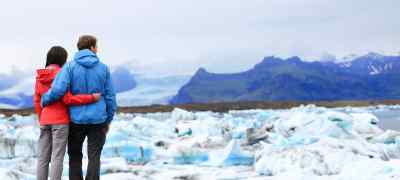Iceland is usually divided into eight general regions for tourism purposes: the Capital region, the Southern Peninsula, West Iceland, Westfjords, North Iceland, the Highlands, East Iceland, and South Iceland. They are primarily geographical, rather than administrative. The country is well-suited for road trips. The Ring Road can be driven in about 12 – 13 hours if you don’t make any stops and brings you around the entire island.
If your client is interested in several different attractions on opposite sides of the country during their trip, they should have no problem hitting everything as long as they rent a car and budget their time properly. Here’s a breakdown of several top attractions in Iceland, and the regions in which they are located.
Capital Region/Reykjavik
A cozy capital city, Reykjavik is sure to charm travelers with its brightly colored buildings, manifold museums, and long list of things to do. When the sun comes out, the city comes alive with people eager to catch a few rays of sun and socialize. The city’s rich arts scene captures a youthful energy that charges the many galleries and hip coffee shops of the area. During the summer, it’s easy to find live music and nightlife here. Year-round, Reykjavik is the ideal start and end point for an Iceland getaway.
Things to See:
Culture: Check out the city’s many art galleries, concert and meeting halls, and monuments and sculptures! You might even be able to catch some street art if you keep your eyes peeled.
Museums: Reykjavik is filled with museums! Be sure to take advantage of free entry to many of the city’s museums with a City Card!
Hallgrímskirkja (Hall-grims-girk-ga): An iconic Lutheran church which is visible from nearly any point in the city.
Harpa: A modern concert hall and conference center in the city known for its glass honeycomb design inspired by Iceland’s landscape.
The Sun Voyager: A sculpture by Jón Gunnar Árnason located in front of the Atlantic Ocean waterfront.
Westfjords
Located in the country’s northwest corner, this is where to find unspoiled wilderness. Here, folklore comes alive in the raw nature that has been kept safe by seclusion and a lack of human interruption. This uninhabited area holds a nature reserve, a spectacular set of waterfalls, and half the world’s population of some bird species.
Things to See:
Hornstrandir Nature Reserve (Horn-strand-deer): A remote, deserted area filled with Iceland’s natural flora and fauna. This is a great place to explore the country’s natural beauty and enjoy outdoor activities such as hiking, kayaking, whale watching, bird watching, fishing, and more.
Rauðasandur Beach (Ray-di-sahn-dur): A beautiful red sand beach in a remote area of the westfjords.
Látrabjarg (Lau-tra-berg): The most-visited tourist attraction in the area. The cliffs are home to millions of birds and an excellent place to spot puffins, guillemots, northern gannets, and razorbills.
Dynjandi (Din-yahn-dih): Also called “Fjallfoss,” this is the largest waterfall in the region and considered one of the most breathtaking in the country.
Major Towns:
**Patreksfjörður (Patricks-fyor-dur): **A town in the southern part of the Westfjords with a population of about 660. Featuring many sites of natural beauty such as Látrabjarg, Dynjandi, and Rauðasandur, this area is a growing center for tourism.
Ísafjörður (Eesa-fyor-dur): By far the region’s largest town, the area boasts a selections of restaurants and cafes as well as offering a charming base for travelers.
Bolungarvík (Bowl-un-gar-vik): A fishing village, Bolungarvík is surrounded by mountains and features a national history museum and a fishing museum. With 950 inhabitants, it is the second-largest municipality in the area. The nearby locations are popular for hiking, camping, bird-watching, and horseback riding.
Hólmavík (Holm-a-vik): A town with a storied history of witchcraft, witch-hunting, and sorcery, Hólmavík also offers a Sheep Farming Museum, restaurants, a golf course, and a Tourist Information Center in addition to the Museum of Sorcery & Witchcraft.
North Iceland
Head North for the second largest urban area in Iceland. Akureyri, perched along the island’s longest fjord, is steeped in culture and history and calls travelers with the allure of golf, all the offerings of Lake Mývatn and its surrounding wetlands, and the summer’s midnight sun.
Things to See:
Ásbyrgi (Ows-byrg-ee): The capital city of the Hidden People of Iceland, this area is steeped in folklore and mysticism. Ásbyrgi is a glacial canyon which Viking settlers believed to be a hoof print from Odin’s horse.
Dettifoss (Det-ti-foss): Notable for being Europe’s most powerful waterfall and also its greyish color, which is due to the sediment in the glacial runoff that feeds the falls.
Goðafoss (GO-thuh-foss): One of Iceland’s most breathtaking waterfalls. After Christianity was made the official religion of Iceland in the year 1000, statues of Norse gods were thrown into this waterfall.
Lake Mývatn (Mee-vahtn): A stunning stop on The Diamond Circle, this volcanic lake features bubbling mud pools and geothermal caves as the north’s answer to the Blue Lagoon.
Kolugljúfur canyon (Kolu-glu-fur): A deep gorge with several impressive falls.
Kálfshamarsvík (Kalf-shah-mars-veek): An idyllic bayside cove; a true hidden gem by the Kálfshamarsnes Cape. Basalts column cliffs create an otherworldly effect surrounding the water.
Major Towns:
Akureyri (Ah-koo-rare-ee): Located very close to the Arctic Circle, this city is packed with trendy coffee shops, high-quality restaurants, art galleries, and even some nightlife.
Sauðárkrókur (Say-dur-kraw-kur): A bustling town with tons to offer visitors including exhibitions, museums, entertainment, shopping, dining, workshops, a swimming pool, and more.
Húsavík (Hoo-sa-vik): Generally regarded as the northeast’s prettiest fishing village, Húsavík is an excellent destination for whale watching. The thriving ecosystem in the Skjálfandi Bay provides the best chances of seeing whales here than anywhere else in Iceland.
Dalvík (Dahl-veek): A popular spot for skiing, the village offers visitors the Byggðasafnið Hvoll museum, the Fiskidagurinn mikli festival, and beautiful bay views.
East Iceland
This is where you will find the country’s largest forest in Vatnajökull National Park, farmland, and a variety of fjords and islands. Due to the area’s natural harbors, you will also find a range of fishing villages and seaside communities on the coast.
Things to See:
Jökulsárlón (Yeu-kul-sarl-tron): A well-known glacial lake filled with floating icebergs and marine life.
Skaftafell (Skaf-tafell): National park with volcanoes, glaciers, campsites, and hiking trails for all skill levels.
Svartifoss (Svar-ti-foss): An otherworldly 65-foot tall waterfall plummeting down striking hexagonal basalt columns.
Hvannadalshnúkur (KWANNA-dalsh-nyooker): The highest pyramidal volcano peak in Iceland.
Fjallsárlón (Fyall-sar-lon): An iceberg lagoon at the south end of the glacier Vatnajökull.
Breiðamerkurjökull (Bray-lah-mehr-kur-yeur-kotl): An outlet glacier (ice cave) of Vatnajökull that ends at Jökulsárlón. It is breaking down over time and will eventually melt.
Öræfajökull (Err-iver-yerkotl): The largest active volcano and highest peak in Iceland, this site is located in Vatnajökull National Park and is covered by the glacier.
Major Towns:
Egilsstaðir (Ay-ill-sta-vish): Located on the banks of the Lagarfljót river, this town is a center for local commerce and is growing as a place to find good dining options and quality accommodations.
Seydisfjordur (Sey-dis-fyor-dyor): A very friendly town rich with picturesque beauty, colorful wooden houses, and a lively community of artists, musicians, craftspeople, and students.
Fjarðabyggð (Fyard-a-byg-d): The easternmost municipality in Iceland, the name means “the settlement of the fjords.” It is known for its idyllic beauty and six fjords.
West Iceland
Chock full of geological diversity and natural wonder, west Iceland offers a stunning sampling of what the country has to offer. Seamlessly blending culture, history, nature, and folklore, this region will be an unforgettable part of any trip to Iceland. With many of the popular sites in very close proximity to each other, it is easy to see west Iceland at a leisurely pace and slow down enough to really soak in the raw power of the nature around you.
Things to See:
Snæfellsjökull National Park (Sniye-fell-syoo-coot): Covering much of Iceland’s western tip, this national park holds lava tubes and fields, native fauna, and unbeatable hiking and sightseeing.
Hraunfossar (Hrouwn-foss-ar): A stunning collection of waterfalls which stream from cooled lava.
Barnafoss (Bar-na-foss): A series of rapids running through a lava plain and ending in cascades.
Deildartunguhver (Del-dar-tun-ghar-vehr): Known as Europe’s most powerful hot spring, this water heats Akranes!
Kirkjufell (Kyierk-you-fell): This beautiful landmark is considered the most photographed mountain in the country. It has been listed as one of the top 10 most beautiful mountains in the world.
Surtshellir (Surt-sad-layher): This mile-long lava cave is composed of vitrified layers of magma and basalt.
Major Towns:
Stykkisholmur (Stick-ish-hol-mur): An enchanting town (with free Wi-Fi throughout!) that makes a great base to explore the region.
Akranes (Ahk-rah-nes): An old fishing town with a thriving community, Akranes is part of the green energy revolution and is heated with geothermal heating from Reykjavik.
Borgarnes (Bor-gar-nes): A small town with a long history. Here, you can find a fun small-town vibe, excellent scenery, and one of Iceland’s best museums.
South Iceland
Home to some of the country’s most-visited tourist attractions, Iceland’s south coast is known for its beauty. Here, you will find the Golden Circle route, many of the country’s most famous waterfalls, and several other natural wonders. The coastal villages here are also famous for their fresh seafood.
Things to See:
Þingvellir (Thing-vell-eer): A historic site and national park, known for holding the site of Iceland’s parliament from the 10th – 18th centuries. Þingvellir Church and stone shelter ruins are located here as well.
Gullfoss (Gool-fahs): One of the most popular tourist attractions in the country, Gullfoss is a waterfall located in the canyon of Hvítá river.
Skógafoss (Sko-ga-foss): A waterfall located on the Skógá river, this popular site is at the cliffs of the former coastline.
Geysir (Gay-seer): Also known as the Great Geysir, this is a favorite stop along the Golden Circle and is a very active hot spring area that erupts every few minutes and is surrounded by boiling mud pits.
Seljalandsfoss (Sell-ya-lands-foss): One of Iceland’s most famous waterfalls, this one is located just off of Route 1 and the road that leads to Þórsmörk Road 249.
Major Towns:
Selfoss (Sell-foss): A small town on the banks of the Ölfusá river.
Hveragerði (Kver-a-ger-thi): This is a “greenhouse village” powered by geothermal energy.
Vestmannaeyjar (Vest-manny-yar): A town on Heimaey that was affected in 1973 by the Eldfell eruption.
Höfn (Herph-ney): Next to the fjord Hornafjörður in the southeast, this fishing town is the second largest in the area and offers scenic views of Vatnajökull.
The Southern Peninsula
Also called the Reykjanes Peninsula, this area is a geothermal phenomenon. This is the place to find the famous Blue Lagoon, plenty of lighthouses, hot springs, and tons of recreational activities. The division between the American and European tectonic plates is very clear in the area and the natural features include volcanic craters, lava fields, caves, hot springs, geothermal waters, and plenty of restaurants, museums, festivals, and things to do.
Things to See:
Blue Lagoon: This world-famous geothermal spa is a must-visit for travelers. Be sure to book in advance, this is a very popular stop and spots are limited.
Gunnuhver: A geothermal area containing fumaroles and mud pots collectively named after a female ghost that was laid there.
Krýsuvík (Chris-a-vik): This is a colorful geothermal area that looks like another planet.
**Valahnúkur: **A mountain composed of tuff layers, pillow lave, and breccia. The mountain was formed in a single eruption and provides beautiful views of the scenery surrounding the area.
Keilir (Kay-ler): A small volcanic mountain that is an easy trip between Reykjavik and the Blue Lagoon.
Bridge between Continents: This small footbridge stretches over a major fissure in the earth. It was built to symbolize the connection between North America and Europe.
Major Towns:
Grindavík (Grin-da-vik): This fishing village is where you will find the Blue Lagoon, the Icelandic Saltfish Museum, and other novel attractions.
Reykjanesbær (Reyk-yan-es-bayer): A small town with a proud history, you can find attractions such as the Viking World Museum, the Icelandic Museum of Rock, Viking World, and the Reykjanes Art Museum here.
Highlands:
A previously inaccessible and unexplored wilderness, the Icelandic Highlands are now open to the public for careful visitation in the summer months. The mountainous region is filled with natural hot rivers, woodlands, glaciers, and glacial rivers. The desolate nature requires the utmost preparation, respect, and caution for exploration as there are no nearby towns and no locals to lend a hand if you run into trouble, only unspoiled nature for miles around.
Things to See:
Askja (Ask-ya): A remote caldera located on the nothern side of Vatnajökull National Park. It was formed when a lava chamber under the surface of the earth emptied in an eruption and the roof above it collapsed. It consists of three interlinked cauldrons.
Kjölur (Kyo-luhr): The Kjölur route begins near Gullgoss, passes the Langjökull and Hofsjökull glaciers, and goes by Hveravellir, where you can find accommodation. It continues north through the mini lake district around the Blanda river and the Blöndulón reservoir and emerges at the Route 1 highway in Blönduós.
Kverkfjöll (Kvack-fyall): A mountain range on the northeast of Vatnajökull. It holds one of Iceland’s most active high-temperature geothermal areas.
Landmannalaugar (Land-man-a-lay-gar): Renowned as one of the most stunning areas in the highlands for its multicolored mountains, clear blue lakes, and bubbling hot springs, this area is popular for hiking and relaxing.
Sprengisandur (Spring-ees-ond-ur): This route is the longest stretch between the north and south and is quite desolate. On the drive, you’ll see three glaciers, Hofsjokull to the west and Tungnafellsjokull and Vatnajokull to the east. This route has strong connections with the country’s ancient folklore and was a popular hiding place for outlaws.
Þórsmörk (Thors-mork): Named for the Norse god Thor, this dreamy mountain range offers several very popular hiking routes and volcano huts for camping. There is a sauna and geothermal pool near the campground for use as well.
Back to How to Sell Iceland

